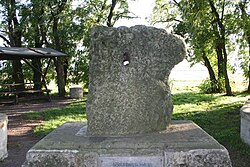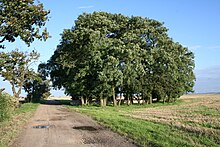Menhir from Gerbstedt
| Menhir from Gerbstedt Hoyerstein, holey stone | ||
|---|---|---|
|
The Gerbstedt menhir |
||
|
|
||
| Coordinates | 51 ° 37 '36 " N , 11 ° 36' 8" E | |
| place | Gerbstedt , Saxony-Anhalt , Germany | |
The menhir of Gerbstedt (also called Hoyerstein or Löchriger Stein ) is a menhir near Gerbstedt in the district of Mansfeld-Südharz in Saxony-Anhalt .
location
The stone is located about 1.25 km west of Gerbstedt, on the south side of a dirt road in a small grove . However, it was only moved here in 1898. Originally it stood about 100 m further south in the area of the Dankendorf desert . During the implementation, a stone box grave was discovered 2 m from the original location .
description
The menhir consists of brown coal quartzite and is heavily weathered on one side, but smooth on the other. Its height is 110 cm, the width 100 cm and the depth 35 cm. The stone has roughly the shape of a rectangular plate, but has a bulge on one side at the top. In the middle of the upper half there is an apparently naturally created, artificially enlarged hole with a height of 14 cm and a width of 9 cm. At its current location, it is embedded in a base and serves to commemorate Count Hoyer I of Mansfeld, who fell in the battle of the Welfesholz . The inscription on the base reads:
“ Holey stone.
Battle of the Welfesholze
in 1115.
I, Count Hoyer unborn,
have not yet lost a battle,
as much as I reach into this stone,
this battle must also be mine. "
Finds from the area around the stone come from the band ceramics , the Bernburg culture , the Walternienburg culture , the cord ceramics culture , the full bronze age , the Slavic early Middle Ages and the Middle Ages .
The menhir in legends and customs
Around the menhir is the legend, passed down among others by the Brothers Grimm , that there was a thunderstorm in the run-up to the battle of the Welfesholz and the stone therefore became very soft. Count Hoyer could therefore reach into the stone with his hand and swore, as sure as he could reach into the stone, he would also have to win the upcoming battle.
The use of the menhir as a nail stone is related to the belief that thunderstorms would soften stones . It is said that nails could only be hammered into stones during thunderstorms. In the 1950s, Waldtraut Schrickel was still able to detect driven nails on all sides of the menhir. In the meantime, however, these have been completely removed.
literature
- Paul Grimm : Of upright stones (menhirs) in Central Germany. In: Mitteldeutsche Volkheit. Volume 3, Issue 4, 1936, p. 70.
- Johannes Groht : Menhirs in Germany. State Office for Monument Preservation and Archeology Saxony-Anhalt, Halle (Saale) 2013, ISBN 978-3-943904-18-5 , pp. 427, 452.
- Horst Kirchner : The menhirs in Central Europe and the menhir thought. Academy of Sciences and Literature, Treatises of the Humanities and Social Sciences Class, Born 1955, No. 9, Wiesbaden 1955, p. 178.
- Waldtraut Schrickel : Western European elements in the Neolithic and the Early Bronze Age of Central Germany. Part I. Catalog. Publications of the State Museum for Prehistory Dresden, Volume 5, VEB Bibliographisches Institut, Leipzig 1957, pp. 29–32.
- Erhard Schröter : soil monuments of the Halle district. In: Annual publication for Central German prehistory. Volume 69, 1986, p. 74.
- Britta Schulze-Thulin : Large stone graves and menhirs. Saxony-Anhalt • Thuringia • Saxony . Mitteldeutscher Verlag, Halle (Saale) 2007, p. 83.
Web links
- The Megalithic Portal: Hoyerstein (Holey Stone)
- tw.strahl.org: Menhir "The holey stone" ("Hoyerstein"), Gerbstedt near Hettstedt




